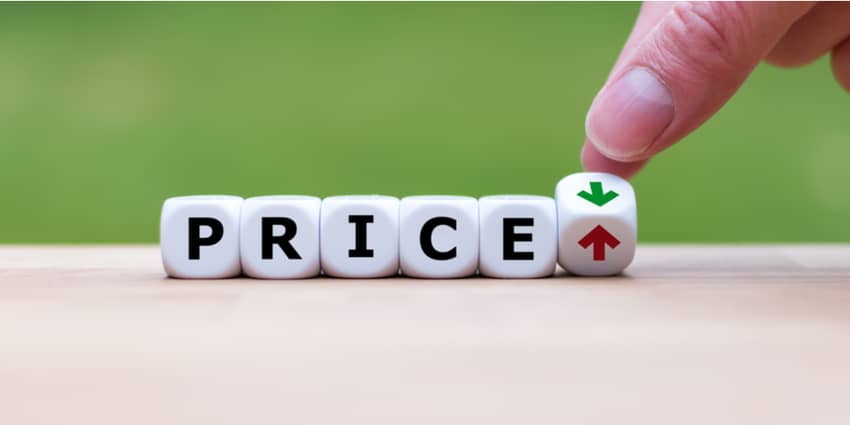Learning how to price a product can be tricky - set prices too low and you won't make a profit, but set them too high and you'll put customers off buying. So it's important to strike the right balance to keep your customers (and your bank manager) happy!
When deciding on what price to list a product for it's important to take into account factors like season, economic climate, and competition. If you are trying to sell beachwear in January you might need to price your products at the lower end of the scale to entice bargain hunters to purchase, however in July or August the same products may sell for a premium!
Whether you're reviewing your existing website or you have just started selling online, in this product pricing guide we'll cover the importance of having a plan, how to decide on a price, and ways you can lower your costs to keep your products affordable for customers.
Why is product pricing important?
There's no point having an amazing website showcasing the best products if your price point is wrong.
Pricing demonstrates a products worth
You want your customers to know that your products have value and that it's worth their investment. Your pricing strategy can show customers how much you value your products. But we need to be realistic too, you probably won't have much luck selling a doodle you did of a pony for $50,000 - even if you do think it's great!
Which leads me nicely onto; pricing also reflects quality, but customers will be able to tell if you're overcharging. If your products are made from higher quality ingredients that will stand the test of time, then customers will be happy to pay more for them. However, if you overprice cheap goods that break easily then you probably won't get many repeat customers and you might end up with a lot of bad reviews.
Pricing draws customers in
Prices are a major way to draw customers to your website. By pricing your products in a way that matches what customers are willing to pay and promoting this across social media/online ads, you can increase sales exponentially. Try running special promotions on products you can afford to discount to have an exciting headline price to draw customers in.
Trialling prices to see what customers are likely to pay can be a good way to find the right price match.
Prices keep customers returning
If you sell consumables like beauty products or pet essentials (a great market to be in), you'll want customers to keep coming back to replenish their purchases with you. This is dependant on how much it'll cost them. Customers will have an idea of what the cost should be, if you're too expensive they may just buy the product somewhere else, if you're too cheap then customers may think it's an inferior product or a fake - so tread carefully!
Creating the right pricing strategy that is affordable enough to accommodate the average customer is important. If you want all those dog-lovers out there to buy your products exclusively, you'll need pricing that is affordable enough for them to do so!
What pricing strategies do businesses use most?
Most pricing strategies out there are designed to keep businesses profitable while ensuring your product range is affordable enough to grow your customer base. These are some of the most common methods for knowing how to price a product to sell online or in retail:
- Cost-plus pricing: this pricing plan is just adding together the cost of your materials, labour, and fixed costs (e.g. website subscription). Say this came to $15, you'll then need to charge $30 to make a 50% profit. Simply put, this plan is all about charging more than it takes to produce so you can gain a profit.
- Competitor pricing: monitoring competitors over time and charging lower prices than them can attract customers to convert to your business. If you can't charge less than them you'll need to demonstrate why you're better, be it shipping options or sustainability.
- Price skimming: this is when businesses charge a high initial price and reduce this over time. This can be useful for season dependant products or trends. It also works best for tech - take Apple as a good example, who charge much less for the older models.
- Psychological pricing: this is when businesses use '$99.99' instead of '$100' or place a more expensive item next to the item you want to sell, using tactics to make a particular product seem more affordable.
Many companies use a combination of some or all of the above. It's important to be adaptable and try different approaches to see what works best for your brand and suits your customers.
How to price products
Now that you know a little bit of product pricing psychology, let's get into some actionable steps you can use to learn how to decide on the price of a product.
Know who your customers are
Understanding your customer base is probably one of the most important things for every brand to know. If you know who you are selling to, then you know what they can afford (and are willing) to pay for your products. You can do a bit of follower research on social media - have a look at what age group interacts with your brand most. Or ask for reviews on your products and ask them to provide their age.
If your customers are mostly defined by the 35-50 age group, you may get away with charging slightly more for your products as this demographic will likely have an established source of income.
If however, your products are more popular with the 16-25 age group, charging less will attract more buyers! Few teenagers will have the funds to pay $45 for a lipstick.
Of course age is just one demographic that affects the price people are able to pay for products. Delve into your Google Analytics to see who your customers are to gain some valuable information.
Research your industry
It's really important to keep up with your industry - keeping track of your competitors, industry news/insights and market research is useful when you're learning how to price a product to sell.
You may have a huge amount of competition or you may have only a few, either way, you'll need to look at how much they're charging for products. Have a look at what's most popular on their website or what they're trying to push.
Don't forget to see how much they charge for shipping, as (with us!) you could definitely undercut the competition by offering customers cheaper shipping options!
Optimise your service
Optimise your supply chain can just mean slimming down what you spend on labour, fixed costs, materials, or other expenses. You may already be spending the minimum you can to maintain your brand's quality, so don't compromise on this. You can push costs down even further by teaming up with a discounted shipping provider like us.
Once you've got costs as low as they can go, you can know how to calculate a price for your products! The cost-plus pricing strategy can be useful to create price points in this scenario, just make sure you have an accurate amount for your total production costs.
Ask around
Knowing how to price a product can be helped by knowing what customers would be willing to pay. Ask for previous customer feedback, or just put out an open call for product surveys from followers on social media.
This means of data collection can give you an idea of how to price a product to sell, but also who your target audience is. But make sure you take into account the economic moment you're in because sometimes it's not that your products are sub-par, it's just that they can't afford it right now - the old classic, it's not you, it's me!
Stay flexible
Prices are never static, you've got to keep them moving! Your pricing should roll with the waves of the economy to stay afloat and in your customer's interests. Plus, now that you're in the game and using economy pricing strategies as well, your competitors will be frantically finding new ways to get their prices down as competitively low as yours, so stay focused and keep your pricing strategies fresh!
Tools to help with pricing strategies
If you're just getting started or if you're in a niche market with few competitors, then calculating product prices yourself can work just fine. If, however, your industry is pretty saturated and you're a bit lost there are some pricing solutions that can help.
Need to cut costs even further?
Lots of brands lose out on business because their shipping costs are too high and so they can't lower their product prices. Some brands try and offset this by skimping on the quality of their products but we don't think you should do this. By finding a shipping service that's right for you, you can refine your shipping strategy, reduce costs and provide customers with multiple delivery options to suit their needs.
At Interparcel we care about small businesses, so we listened to what our our customer's needed and created our Shipping Manager to make business delivery easy. We integrate with all the major eCommerce platforms like eBay, Etsy, Shopify, and more. We save you time and money, so that you can focus on getting that sale!
With our Shipping Manager you have access to:
- Advanced shipping solutions: collect orders from your store and multiple other sites in one area
- In-built address collection and correction, no more manual errors
- New branded tracking, create a seamless brand experience when customers track orders
- Despatch orders in a few clicks and carry on selling!
Integrating your store with our Shipping Manager is free - all you need to do is create an account with us and import your orders across to benefit from our hassle-free order processing and discounted shipping services. We've saved many small businesses lots on shipping costs, so they were able to know how to price a product or two with this in mind - so give us a try!
If you have any questions about any of our services be sure to give us a call, live chat message or email










 Facebook
Facebook Twitter
Twitter Instagram
Instagram Linked In
Linked In YouTube
YouTube